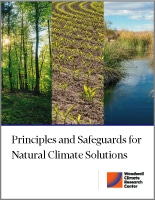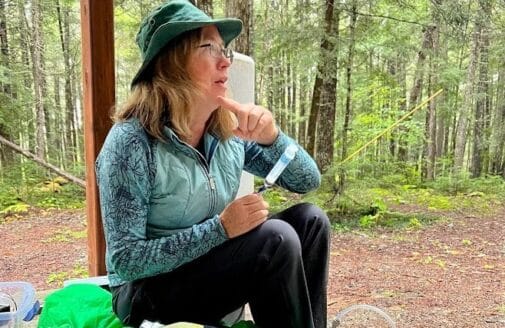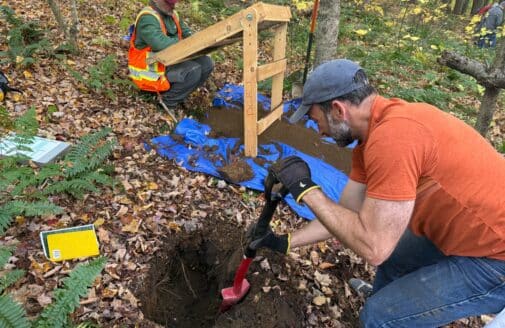Guiding principles for just, effective natural climate solutions

The NCS guiding principles document was updated October 2023. Please see the newer post for current content. This post is left in place for archival purposes.
On the heels of the Biden Administration’s Leaders Summit on Climate, Woodwell Climate Research Center released a set of five science-based principles to guide the use of natural climate solutions to meet emissions targets associated with the Paris Climate Agreement and limit global warming to less than 2°C. The principles address how both public and private-sector decision-makers at the national and sub-national level can incorporate natural carbon capture and storage into climate plans while protecting the wellbeing of local communities and the many services derived from the land and waters of the U.S., especially biodiversity and food production.
Currently, land, inland waters, and coastal ecosystems remove about 30% of global carbon dioxide emissions each year, and have the potential to do even more. However, maximizing these ecosystems’ capacity to mitigate climate change will require careful analysis of options for deployment over the next few decades, and monitoring of results that may be impacted by climate change.
“Natural climate solutions are an essential component of reaching net-zero greenhouse gas emissions,” said Richard Birdsey, Woodwell Climate Senior Scientist and paper co-author. “Realizing their full potential requires taking into account the many co-benefits of ecosystems as well as the possible unintended effects of these solutions.”
The framework underlying these principles includes considerations of time, space, and community. The time dimension recognizes that natural climate solutions involve changes in ecosystems and ecosystem management that have impacts that span decades and centuries. The effectiveness of a particular climate solution will vary over these timeframes—some will be effective in the short term, and some in the long term as climate changes and other factors evolve. Likewise, some will be ineffective at times and so the expected benefits as well as co-benefits need to be evaluated now and for the future.
The spatial dimension reflects that ecosystems are highly variable geographically, as are the various factors that influence ecosystems. For example, natural disturbances such as wildfire are much more common and severe in areas where drought and high temperatures are prevalent. Existing management practices are also highly variable, with some regions dominated by agriculture, some by forest management, and some by protection from human-caused disturbances. Potential solutions will be different for these categories, as will the effectiveness of each for reducing greenhouse gas emissions to the atmosphere.
The community, or human, dimension is critical because natural climate solutions are implemented by people within specific social and economic contexts. All solutions have consequences that go beyond the goal of reducing greenhouse gases, and people will be affected in different ways. Impacts may be positive, such as providing jobs or cooling communities by planting trees near buildings, or negative by increasing the costs of goods and services or impacting specific economic sectors, such as agriculture and the forest products industry.

Therefore, it is essential to evaluate how deployment strategies will affect different communities, over different time frames, and in different regions. The core principles laid out in the paper were created with input from experts in developing and implementing climate mitigation strategies involving ecosystems and management, and include the following:
- Natural climate solutions are identified and designed with full consideration of risks from climate extremes, natural disturbances, and socioeconomic events.
Many natural climate solutions will take time to reduce net greenhouse gas emissions, exceptions being reducing deforestation and forest degradation, delaying harvest, and reducing emissions from agricultural soils. If benefits are expected to accrue decades into the future, the solutions must consider that climate and other factors will likely be very different and so the expected benefits may not be as great as predicted by current conditions.
- Avoid degrading ecosystems that have high carbon stocks or biodiversity value, and restore those that have already been degraded.
The carbon stored in high-carbon ecosystems may take decades to centuries to replace if the stocks are lost. Avoiding the fragmentation or degradation of these ecosystems can result in an immediate reduction in emissions and can help protect biodiversity. When possible, restore degraded land to native vegetation which can improve biodiversity while increasing carbon stocks to levels consistent with the potential of the site.
- Natural climate solutions are implemented with full engagement of Indigenous Peoples and local communities and work to mitigate inequalities and injustices.
Natural climate solutions should be implemented with full engagement of Indigenous Peoples and local communities in a way that ensures respect for their land, culture, and human rights. The historical legacies and ongoing effects of institutional racism will require particular care to include the knowledge and interests of these communities. When implementing natural climate solutions consultation, participatory engagement, negotiations, and consent should be received.
- Enhance human welfare and “do no harm.”
Natural climate solutions should aim to generate a net enhancement to human welfare, while doing no harm to impacted stakeholders. If the tradeoffs between the private and public benefits from policy choices are clearly defined and quantified, negative outcomes can be identified and mitigated to the greatest extent possible. Unless natural climate solutions can be demonstrated to have clear overall benefits to society and impacted stakeholders, and private costs mitigated, they are unlikely to be adopted.
- Practice full system accounting so that all effects on the carbon cycle are assessed, and the contributions of a given natural climate solution can be evaluated.
Assessing the climate impacts of natural climate solutions requires a systems approach because of the connections between agriculture, forests, land use, food and fiber production, and energy production. It is therefore essential to practice full system carbon accounting including the effects of activities on ecosystems and their ability to maintain or increase carbon stocks, as well as impacts on fossil fuel emissions from related economic sectors. Full system accounting should be linked with effective monitoring and reporting.
Woodwell Climate scientists and team members Dr. Richard Birdsey, Natalie Baillargeon, Dr. Glenn Bush, Dr. Richard (Skee) Houghton, Dave McGlinchey, Dr. Sue Natali, Dr. Wayne Walker, and Dr. Zach Zobel, plus five external reviewers participated in the development of this paper.
To learn more and read the paper in full, visit woodwellclimate.org/ncs-principles.









